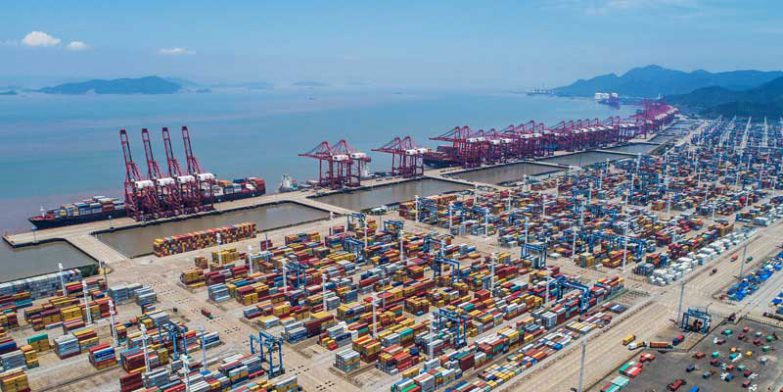
The traditional Chinese New Year air and sea freight demand spike was extremely muted this year, with the container shipping lines reducing the number of westbound departures due to the lack of cargo demand and while we expect blank sailings and vessel diversions to continue, airlines are reintroducing China services following the easing of pandemic measures.
The continued fall in global container freight rates that began last year, abated somewhat in January on major routes. Air freight volumes have been trending down since the first half of 2022 and the first half of 2023 continues to look bleak for air freight, with any hope of an early recovery receding.
OCEAN
In the month up to the middle of January, 14% of all ex-Asia sailings were cancelled, of which 53% were trans-Pacific sailings, followed by 24% on the Asia-Europe lane and 23% on the trans-Atlantic.
Maersk’s 2022 Q4 volumes were down 14% on 2021 and it announced the suspension of its TP20 transpacific loop just after news broke of their impending split with MSC and the end of the 2M alliance.
The 2M partners reduced their sailings on their Far East – Europe/Med trade by 24%, while the OCEAN Alliance has reduced the number of its westbound voyages by 23% and THE Alliance has the largest percentage of voided sailings at 36%.
Any congestion at US ports is now almost clear, with hardly any ships waiting outside the West Coast ports and very few off the East Coast and Gulf.
Soft volumes through the end of Q1, following factory closures for Asia’s Lunar New Year holidays, will allow ports and inland terminals to clear any remaining backlog.
In general inland transport capacities are now sufficient in most areas, but some chassis shortages persist and seasonal weather delays and restrictions have to be expected for truck and rail moves in Canada and the US.
The big carriers skip sailings to adjust capacity supply in line with lower cargo demand and to avoid further erosion of spot ocean freight rates – but despite their efforts downward pressure on rates continue.
Container shipping lines are diverting vessels from the Asia to Europe and US trade-lanes to more robust routes and markets – with transatlantic and Middle East/India services the biggest beneficiaries – due to weak demand and the blank sailings they have implemented, which are now causing severe space issues.
Even contracted space protection is now at risk, with the largest volume shippers’ containers rolled due to lack of vessels.
ONE and its partners in THE Alliance have been diverting ships round the Cape of Good Hope on return legs of Far East-Europe and Far East-North America east coast sailings to reduce the idle time of vessels caused by blank sailings and other lines may yet follow their lead.
Over half a million teu of capacity was withdrawn from Asia-North America and Asia- Europe trades last year. The highest percentage increase was seen on the transatlantic trade, which recorded a 16.2% increase in capacity with the addition of 162,300 teu slots, as the transatlantic market remained resilient.
On the eastbound transpacific trade-lane the lines claim units costs are up by >40% due to vessel backlogs and inland bottlenecks that add delays and costs to the supply chain, rising prices for bunker and diesel fuel, and administrative costs. Though it has to be noted that these issues have now largely dissipated.
Carriers are looking to secure regular, fixed business from the largest volume shippers (BCOs), offering space protection for those willing to accept premium-priced deals, but potential customers are wary, particularly as so many BCOs’ containers are currently being rolled.
The expected drop of freight rates on the North Europe to US East Coast, is yet to be reflected in the spot indices. In fact CMA have announced a peak season surcharge (PSS) ($1000/teu) to the USA for this trade-lane due to high demand.
AIR
Global air freight volumes remain low, with flat growth, as worldwide high inflation is likely to continue well into 2023, with any expectation of a recovery likely to be in the 3rd and 4th quarters.
Reduced ocean freight costs are encouraging a shift in transport mode from air to sea and rates from China have continued to slip, but despite being a third lower than a year ago, they are still far higher than pre-COVID levels.
Demand ex-South-east Asia remains low, with capacity widely available except for Hanoi, which is experiencing a pre-holiday rush and will require as much advance notice as possible.
In Europe, demand is soft and rates are looking like “normal Q1 levels”. On the upside, ground operations are working well, without the pressure of congestion.
Overall scheduled capacity is 9% up on last year and is more than sufficient to support comparatively lower volumes.
Ample capacity is available on the vast majority of trade-lanes, has been tight on some ex-EMEA and ex-China routes.
CMA CGM has began flying an Airbus A330-200 freighter service four times a week from Shanghai Pudong, which brings them up to 15 scheduled flights per week, connecting Europe, Asia and the US
Lufthansa Cargo is due to add more flights from China, including Hong Kong and Chengdu, while Etihad Cargo has added freighter and passenger flights for Shanghai, with
Cathay Pacific, Hainan and Air China also announcing increases in flights.
With low demand and plenty of capacity, the market has remained aggressive on most trade-lanes and with demand expected to remain low, rates are expected to remain competitive.
The Baltic Air Freight Index (BAI) tracks weekly transactional rates for general cargo and is a weighted average of 17 key trade routes. The BAI slipped nearly 8% in the past week, making it 34% lower than a year ago, but despite that drop the index is still almost double where it was pre-pandemic in January 2020.
Outbound Shanghai fell 9.2% week on week, taking its year-on-year change to – 37.9%, while Hong Kong was down 5.6% WoW, taking it to -41.9% YoY.”
The index also indicated that prices fell from all major outbound locations, with Frankfurt down 5.8% in the week, Heathrow 12%, Chicago 8.6%; China to Europe fell 10% in the week, while China to the US was down 5.4%.
Whatever challenges your supply chain may face, the price and capacity agreements we have in place with our long-term partner air and ocean carriers mean that we continue to deliver resilient and reliable supply chain solutions.
Our purchase order management and supply chain tracking technology support the most demanding global trading regimes, providing transparency and control. EMAIL Andy Costara to learn more and see how our technology can support your supply chain.





